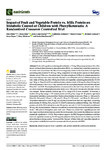Impact of Fruit and Vegetable Protein vs. Milk Protein on Metabolic Control of Children with Phenylketonuria: A Randomized Crossover Controlled Trial
| dc.contributor.author | Pinto, A | |
| dc.contributor.author | Daly, A | |
| dc.contributor.author | Rocha, JC | |
| dc.contributor.author | Ashmore, C | |
| dc.contributor.author | Evans, S | |
| dc.contributor.author | Jackson, R | |
| dc.contributor.author | Payne, A | |
| dc.contributor.author | Hickson, M | |
| dc.contributor.author | MacDonald, A | |
| dc.date.accessioned | 2022-10-31T12:49:17Z | |
| dc.date.available | 2022-10-31T12:49:17Z | |
| dc.date.issued | 2022-10-13 | |
| dc.identifier.issn | 2072-6643 | |
| dc.identifier.issn | 2072-6643 | |
| dc.identifier.other | 4268 | |
| dc.identifier.uri | http://hdl.handle.net/10026.1/19793 | |
| dc.description.abstract |
<jats:p>Fruits and vegetables containing phenylalanine ≤ 75 mg/100 g (except potatoes) have little impact on blood phenylalanine in phenylketonuria (PKU). In a randomized, controlled, crossover intervention trial, we examined the effect of increasing phenylalanine intake from fruits and vegetables, containing phenylalanine 76–100 mg /100 g, compared with milk protein sources on blood phenylalanine control. This was a five-phase study (4 weeks each phase). In Phase A, patients remained on their usual diet and then were randomly allocated to start Phase B and C (an additional phenylalanine intake of 50 mg/day, then 100 mg from fruits and vegetables containing phenylalanine 76–100 mg/100 g) or Phase D and E (an additional phenylalanine intake of 50 mg/day then 100 mg/day from milk sources). There was a 7-day washout with the usual phenylalanine-restricted diet between Phase B/C and D/E. Blood phenylalanine was measured on the last 3 days of each week. If four out of six consecutive blood phenylalanine levels were >360 μmol/L in one arm, this intervention was stopped. Sixteen patients (median age 10.5 y; range 6–12 y) were recruited. At baseline, a median of 6 g/day (range: 3–25) natural protein and 60 g/day (range: 60–80) protein equivalent from protein substitute were prescribed. Median phenylalanine levels were: Phase A—240 μmol/L; Phase B—260 μmol/L; Phase C—280 μmol/L; Phase D—270 μmol/L and Phase E—280 μmol/L. All patients tolerated an extra 50 mg/day of phenylalanine from fruit and vegetables, containing phenylalanine 76–100 mg/100 g, but only 11/16 (69%) tolerated an additional 100 mg /day. With milk protein, only 8/16 (50%) tolerated an extra 50 mg/day and only 5/16 (31%) tolerated an additional 100 mg/day of phenylalanine. Tolerance was defined as maintaining consistent blood phenylalanine levels < 360 μmol/L throughout each study arm. There was a trend that vegetable protein had less impact on blood phenylalanine control than milk protein, but overall, the differences were not statistically significant (p = 0.152). This evidence supports the PKU European Guidelines cutoff that fruit and vegetables containing 76–100 mg phenylalanine/100 g should be calculated as part of the phenylalanine exchange system. Tolerance of the ‘free use’ of these fruits and vegetables depends on inter-patient variability but cannot be recommended for all patients with PKU.</jats:p> | |
| dc.format.extent | 4268-4268 | |
| dc.format.medium | Electronic | |
| dc.language | en | |
| dc.language.iso | en | |
| dc.publisher | MDPI | |
| dc.subject | phenylketonuria | |
| dc.subject | fruits | |
| dc.subject | vegetables | |
| dc.subject | milk protein | |
| dc.subject | metabolic control | |
| dc.subject | phenylalanine | |
| dc.title | Impact of Fruit and Vegetable Protein vs. Milk Protein on Metabolic Control of Children with Phenylketonuria: A Randomized Crossover Controlled Trial | |
| dc.type | journal-article | |
| dc.type | Article | |
| plymouth.author-url | https://www.ncbi.nlm.nih.gov/pubmed/36296952 | |
| plymouth.issue | 20 | |
| plymouth.volume | 14 | |
| plymouth.publication-status | Published online | |
| plymouth.journal | Nutrients | |
| dc.identifier.doi | 10.3390/nu14204268 | |
| plymouth.organisational-group | /Plymouth | |
| plymouth.organisational-group | /Plymouth/Faculty of Health | |
| plymouth.organisational-group | /Plymouth/Faculty of Health/School of Health Professions | |
| plymouth.organisational-group | /Plymouth/REF 2021 Researchers by UoA | |
| plymouth.organisational-group | /Plymouth/REF 2021 Researchers by UoA/UoA03 Allied Health Professions, Dentistry, Nursing and Pharmacy | |
| plymouth.organisational-group | /Plymouth/Research Groups | |
| plymouth.organisational-group | /Plymouth/Research Groups/Institute of Health and Community | |
| plymouth.organisational-group | /Plymouth/Research Groups/Plymouth Institute of Health and Care Research (PIHR) | |
| plymouth.organisational-group | /Plymouth/Users by role | |
| plymouth.organisational-group | /Plymouth/Users by role/Academics | |
| dc.publisher.place | Switzerland | |
| dcterms.dateAccepted | 2022-10-08 | |
| dc.rights.embargodate | 2022-11-1 | |
| dc.identifier.eissn | 2072-6643 | |
| dc.rights.embargoperiod | Not known | |
| rioxxterms.versionofrecord | 10.3390/nu14204268 | |
| rioxxterms.licenseref.uri | http://www.rioxx.net/licenses/all-rights-reserved | |
| rioxxterms.type | Journal Article/Review |


